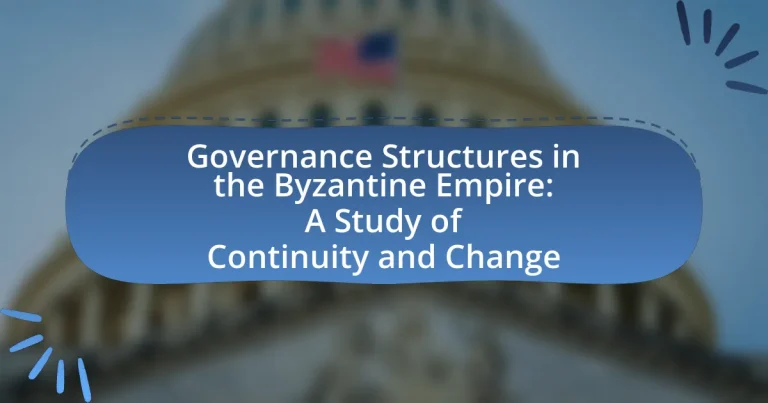The article examines the governance structures of the Byzantine Empire, highlighting key features such as centralized authority, a complex bureaucracy, and military influence. It details the evolution of these structures from Roman influences to a more autocratic system, emphasizing the roles of various officials and the impact of external factors on governance. The article also explores how continuity and change manifested in Byzantine governance, the responsibilities of officials, and the effects of governance on daily life and community dynamics. Additionally, it draws lessons for contemporary governance, emphasizing adaptability, inclusivity, and the importance of historical context.

What are the key features of governance structures in the Byzantine Empire?
The key features of governance structures in the Byzantine Empire include a centralized authority, a complex bureaucracy, and a strong military influence. Centralized authority was embodied in the role of the Emperor, who held supreme power and was considered God’s representative on Earth. The bureaucracy was extensive, with various administrative divisions such as themes, which were military districts that also served as administrative units, allowing for efficient local governance. Additionally, the military played a crucial role in governance, as military leaders often held significant political power and were integral to the defense and stability of the Empire. These features contributed to the longevity and adaptability of Byzantine governance throughout its history.
How did the governance structures evolve over time?
The governance structures of the Byzantine Empire evolved significantly from the early Roman influences to a more centralized and bureaucratic system. Initially, governance was characterized by a blend of Roman law and local customs, but over time, the Byzantine emperors consolidated power, leading to a more autocratic rule. This shift was marked by the establishment of a complex bureaucracy that included various administrative offices, such as the logothetes and the praetorian prefects, which facilitated efficient governance across the empire. The implementation of the Justinian Code in the 6th century further codified laws and administrative practices, reinforcing the emperor’s authority and standardizing governance. Additionally, the influence of the Orthodox Church became integral to governance, intertwining religious and political authority, which shaped the empire’s identity and administrative practices. This evolution reflects a transition from a decentralized system to a more unified and structured governance model, adapting to the empire’s changing political, social, and economic landscapes.
What were the major influences on the evolution of these structures?
The major influences on the evolution of governance structures in the Byzantine Empire included the Roman legal tradition, the Christian Church’s authority, and external pressures from neighboring states. The Roman legal tradition provided a framework for administrative organization and legal governance, which was adapted and expanded upon by Byzantine rulers. The Christian Church’s authority significantly shaped governance, as emperors often sought legitimacy through ecclesiastical endorsement, leading to a fusion of religious and political power. Additionally, external pressures, such as invasions and territorial losses, necessitated adaptations in governance to maintain stability and control, influencing the centralization and bureaucratic nature of the empire’s administration.
How did external factors shape governance in the Byzantine Empire?
External factors significantly shaped governance in the Byzantine Empire through military threats, economic pressures, and diplomatic relations. The constant threat from neighboring powers, such as the Persians and later the Ottoman Turks, necessitated a strong centralized authority and military organization, leading to the establishment of a bureaucratic system that could efficiently mobilize resources for defense. Economic challenges, including trade disruptions and taxation demands, influenced administrative policies and governance structures, prompting reforms like the introduction of the theme system, which decentralized military and civil administration to enhance local governance and defense. Additionally, diplomatic relations with foreign entities, such as alliances and treaties, impacted governance by requiring adaptability in policies and leadership to maintain stability and security. These external factors collectively drove the evolution of Byzantine governance, reflecting a responsive and adaptive political structure.
What roles did different officials play in the governance of the Byzantine Empire?
Different officials in the Byzantine Empire played crucial roles in governance, including the Emperor, who was the supreme authority and made final decisions on laws and policies. The Senate, composed of aristocrats, advised the Emperor and participated in legislative functions, while provincial governors, known as strategoi, managed local administration and military affairs. Additionally, the Praetorian Prefect oversaw civil administration and justice, and the Logothetes handled financial matters, ensuring the empire’s economic stability. These roles were essential for maintaining the complex bureaucratic system that characterized Byzantine governance, reflecting a blend of Roman traditions and local adaptations.
Who were the primary figures in the Byzantine administrative system?
The primary figures in the Byzantine administrative system included the Emperor, the Senate, and various officials such as the Praetorian Prefect, the Logothete, and the Strategos. The Emperor held supreme authority, overseeing all aspects of governance and administration. The Senate, although diminished in power over time, still played a role in legislative functions and advisory capacities. The Praetorian Prefect managed civil administration and law enforcement, while the Logothete handled financial matters and record-keeping. The Strategos was responsible for military command and regional governance. These roles were essential in maintaining the complex bureaucratic structure that characterized Byzantine governance.
What were the responsibilities of these officials?
The responsibilities of officials in the Byzantine Empire included administrative governance, military leadership, and judicial authority. These officials were tasked with implementing imperial policies, managing local resources, and ensuring the security of their regions. For instance, the provincial governors, known as strategoi, were responsible for both civil administration and military defense, reflecting the dual nature of governance in the empire. Additionally, officials like the logothetes managed financial matters, overseeing taxation and state expenditures, which were crucial for maintaining the empire’s economic stability. This structure ensured effective governance and continuity in the Byzantine administrative system.

How did continuity manifest in Byzantine governance structures?
Continuity in Byzantine governance structures manifested through the preservation of imperial authority and administrative practices from the Roman Empire. The Byzantine Empire maintained a centralized bureaucratic system, characterized by a hierarchy of officials who managed various aspects of governance, such as taxation, military, and public works. This structure was rooted in Roman traditions, with the emperor serving as the ultimate authority, a role that was both political and religious, reinforcing stability and continuity. Additionally, the use of codified laws, such as Justinian’s Corpus Juris Civilis, ensured legal consistency and governance continuity, reflecting the Roman legal heritage. The enduring influence of the Church in governance further solidified this continuity, as ecclesiastical leaders often held significant power alongside secular authorities, mirroring the integration of church and state seen in earlier Roman governance.
What traditions were preserved throughout the Byzantine period?
The traditions preserved throughout the Byzantine period included Roman legal frameworks, Christian religious practices, and Greek cultural influences. The Byzantine Empire maintained the Roman law system, exemplified by the Codex Justinianus, which codified existing laws and served as a foundation for legal systems in many European countries. Additionally, the Orthodox Christian Church played a central role in daily life, with rituals and liturgical practices that shaped societal norms. Greek language and philosophy continued to influence education and governance, ensuring that Hellenistic traditions remained integral to Byzantine identity. These elements collectively contributed to the continuity of governance and cultural identity throughout the Byzantine Empire.
How did Roman governance influence Byzantine practices?
Roman governance significantly influenced Byzantine practices by establishing a centralized administrative system that emphasized legalism and bureaucracy. The Byzantine Empire inherited the Roman legal framework, including the Codex Justinianus, which codified Roman law and served as a foundation for Byzantine legal practices. Additionally, the Roman model of provincial governance was adapted in Byzantium, where local governors maintained authority under the emperor’s oversight, ensuring a continuity of administrative control. This structure facilitated efficient tax collection and public order, reflecting the Roman emphasis on a strong state apparatus.
What aspects of governance remained unchanged despite external pressures?
The aspects of governance that remained unchanged in the Byzantine Empire despite external pressures included the centralization of authority and the bureaucratic structure. The Byzantine Empire maintained a strong imperial authority, with the emperor as the ultimate decision-maker, which was crucial for political stability. Additionally, the administrative system, characterized by a complex bureaucracy, continued to function effectively, ensuring the implementation of policies and collection of taxes. Historical records indicate that even during periods of external threats, such as invasions or economic crises, these governance structures persisted, demonstrating their resilience and adaptability.
In what ways did governance structures adapt to changing circumstances?
Governance structures in the Byzantine Empire adapted to changing circumstances through the centralization of authority, the incorporation of local governance, and the development of bureaucratic systems. Centralization occurred as emperors consolidated power to respond to external threats, such as invasions, which necessitated a more unified command structure. The incorporation of local governance allowed for regional leaders to manage local issues effectively, ensuring stability and responsiveness to local needs. Additionally, the development of bureaucratic systems, characterized by a complex hierarchy of officials, enabled efficient administration and resource allocation, particularly during times of economic strain or military conflict. These adaptations were crucial for maintaining the empire’s longevity and stability amidst various challenges.
What reforms were implemented during times of crisis?
During times of crisis in the Byzantine Empire, significant reforms included the establishment of the theme system, which reorganized military and administrative structures to enhance local governance and defense. This reform was implemented in response to external threats, such as invasions, and aimed to create a more efficient and responsive administrative framework. The theme system divided the empire into military districts, each governed by a strategos, who was responsible for both military and civil administration. This dual role allowed for quicker mobilization of resources and troops, thereby strengthening the empire’s resilience during periods of instability. Historical evidence shows that these reforms were crucial in maintaining the empire’s territorial integrity and governance efficiency, particularly during the 7th and 8th centuries when the empire faced significant external pressures.
How did the Byzantine Empire respond to administrative challenges?
The Byzantine Empire responded to administrative challenges by implementing a centralized bureaucratic system that emphasized efficiency and adaptability. This system included the establishment of various administrative offices, such as the logothetes, who managed financial matters, and the strategoi, who oversaw military and provincial governance. Additionally, the Empire utilized a complex legal framework, exemplified by the Corpus Juris Civilis, which codified laws and streamlined legal processes, thereby enhancing administrative coherence. These measures allowed the Byzantine Empire to maintain control over its vast territories and effectively address issues such as corruption, local governance, and military organization.

What were the impacts of governance structures on Byzantine society?
The impacts of governance structures on Byzantine society were profound, shaping its political, social, and economic landscapes. The centralized authority of the Byzantine Empire, exemplified by the role of the emperor as both a political and religious leader, fostered a strong sense of unity and stability. This governance model facilitated efficient administration and the implementation of laws, which contributed to the empire’s longevity and resilience against external threats.
Moreover, the bureaucratic system, characterized by a complex hierarchy of officials, allowed for effective tax collection and resource management, which supported public works and military funding. The use of local governors, or strategoi, helped maintain order and respond to regional issues, further embedding governance into the daily lives of citizens.
Additionally, the governance structures promoted a blend of Roman legal traditions and Christian values, influencing societal norms and cultural development. The Codex Justinianus, for instance, codified laws that reflected both imperial authority and moral principles, impacting legal practices throughout the empire.
Overall, the governance structures of the Byzantine Empire not only ensured political stability but also shaped the cultural and social fabric of Byzantine society, demonstrating the intricate relationship between governance and societal development.
How did governance affect the daily lives of Byzantine citizens?
Governance in the Byzantine Empire significantly influenced the daily lives of its citizens through the implementation of laws, taxation, and public services. The centralized authority of the emperor established a legal framework that regulated various aspects of life, including trade, property rights, and social conduct, ensuring stability and order. For instance, the Justinian Code, enacted in the 6th century, codified existing laws and provided a comprehensive legal system that citizens relied upon for justice and civil rights. Additionally, the Byzantine tax system required citizens to contribute to the state, which funded public infrastructure such as roads, aqueducts, and churches, directly impacting their living conditions and community resources. Furthermore, local governance structures, such as the role of the praefectus, facilitated the administration of these laws and services, allowing for a degree of local involvement in governance that affected citizens’ daily interactions with authority.
What role did local governance play in community life?
Local governance in the Byzantine Empire played a crucial role in shaping community life by facilitating administration, justice, and resource distribution at the local level. Local officials, such as the praefectus and the curiales, were responsible for implementing imperial policies, maintaining public order, and managing local finances, which directly impacted the daily lives of citizens. For instance, these officials oversaw tax collection and public works, ensuring that communities had the necessary infrastructure and services. Additionally, local governance provided a platform for civic participation, allowing residents to engage in decision-making processes that affected their lives, thereby fostering a sense of community and belonging. This structure of governance not only maintained stability but also promoted social cohesion within the diverse populations of the Byzantine Empire.
How did the central authority influence local administration?
The central authority in the Byzantine Empire significantly influenced local administration by establishing a hierarchical governance structure that centralized power and standardized administrative practices. This influence was evident through the appointment of governors, known as strategoi, who were directly accountable to the emperor, ensuring that local policies aligned with imperial directives. Additionally, the central authority implemented tax regulations and legal codes that local administrations were required to follow, thereby maintaining control over economic and judicial matters. Historical records indicate that during the reign of Emperor Justinian I, reforms were enacted to streamline local governance, which included codifying laws that local officials had to enforce, further solidifying the central authority’s impact on local administration.
What lessons can be learned from the governance structures of the Byzantine Empire?
The governance structures of the Byzantine Empire illustrate the importance of centralized authority combined with a complex bureaucratic system. This duality allowed for effective administration across diverse territories, as seen in the implementation of the theme system, which organized military and civil administration. The Byzantine emphasis on legalism and codification, exemplified by Justinian’s Corpus Juris Civilis, underscores the value of a structured legal framework in maintaining order and governance. Additionally, the adaptability of Byzantine governance in response to external pressures, such as invasions and economic challenges, highlights the necessity of flexibility and resilience in political structures. These lessons emphasize the significance of a strong central authority, a well-defined legal system, and the ability to adapt to changing circumstances in effective governance.
How can modern governance benefit from studying Byzantine practices?
Modern governance can benefit from studying Byzantine practices by adopting their effective administrative structures and legal frameworks. The Byzantine Empire utilized a complex bureaucracy that allowed for efficient governance across diverse territories, demonstrating the importance of a well-organized administrative system. Additionally, the Byzantine legal code, particularly the Corpus Juris Civilis, established principles of justice and governance that have influenced contemporary legal systems. This historical context illustrates how Byzantine practices can inform modern governance by emphasizing the significance of structured administration and a robust legal foundation for maintaining order and stability.
What are the key takeaways for contemporary governance challenges?
Key takeaways for contemporary governance challenges include the importance of adaptability, the need for inclusive decision-making, and the significance of historical context in shaping governance structures. Adaptability is crucial as governance systems must respond to rapid social, economic, and technological changes, similar to how the Byzantine Empire evolved its administrative practices to address shifting political landscapes. Inclusive decision-making fosters legitimacy and public trust, reflecting the Byzantine emphasis on integrating diverse perspectives within its governance. Lastly, understanding historical context aids in recognizing the long-term implications of governance choices, as seen in the Byzantine Empire’s legacy influencing modern governance frameworks.


